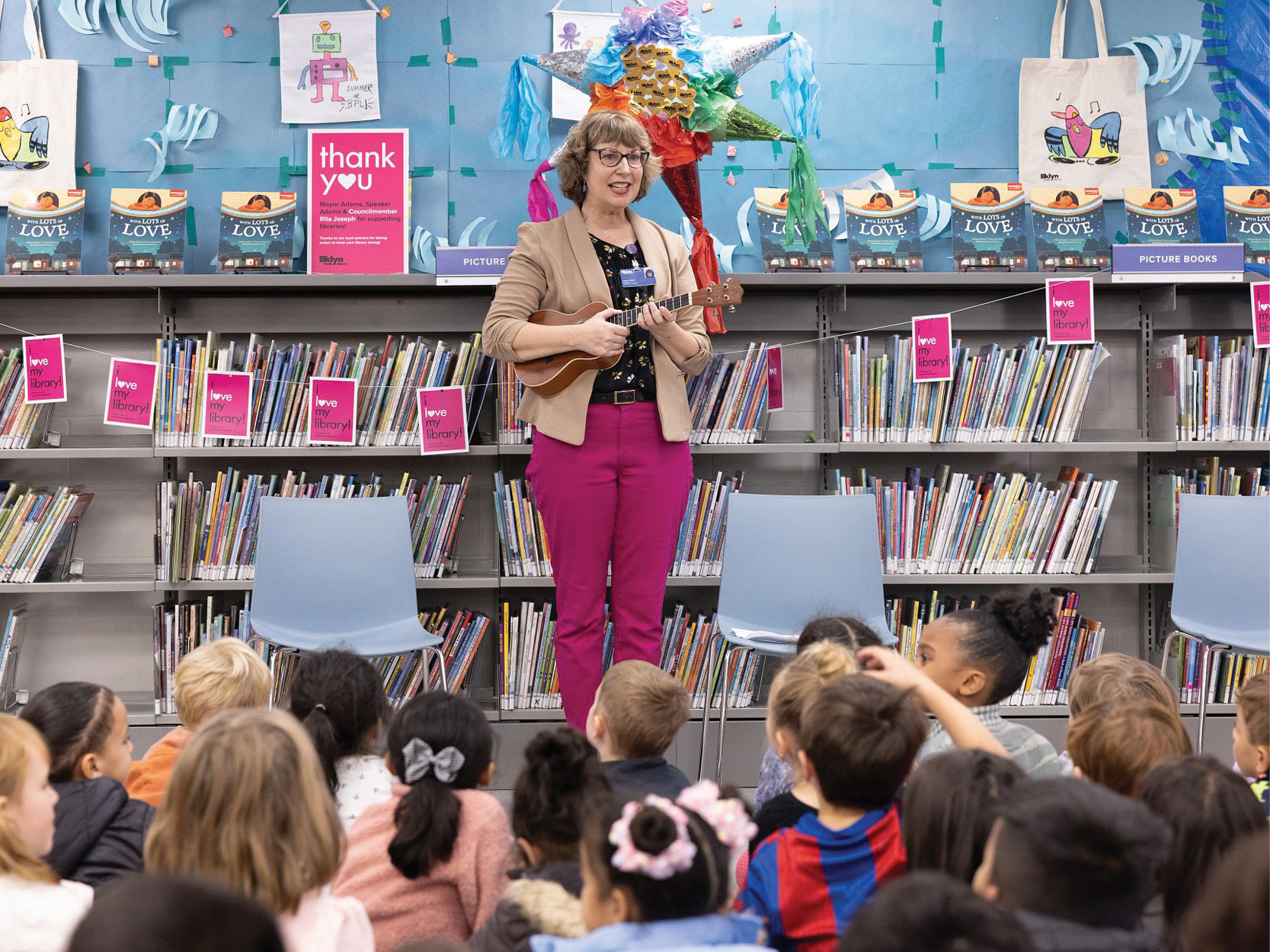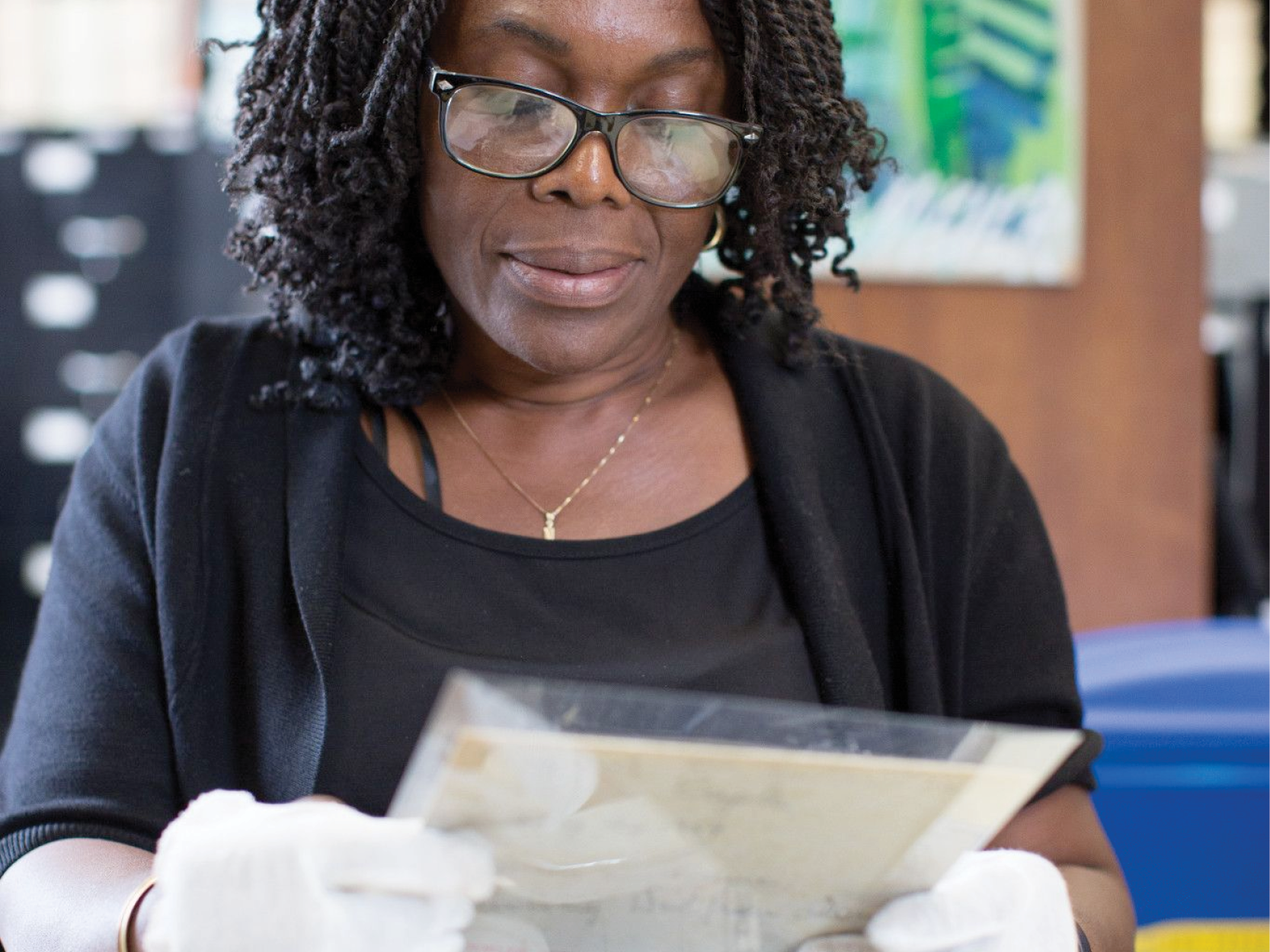Books on conveyor belts, book vacuums and books in the mail. This episode of “Borrowed” will take you behind the scenes to see how books travel around the boroughs, from Long Island City to Bensonhurst to your bedside table.
Click here for a full list of book recommendations, curated for this episode, "Books Are Not Dead."
Click here for a full list of book recommendations, curated for this episode, "Books Are Not Dead."
Episode Transcript
Felice Belle Hey, Krissa.
Krissa Corbett Cavouras Hi, Felice.
Felice Belle Do you remember the first time you walked into a library in Brooklyn?
Krissa Corbett Cavouras You know, I do. And it’s because it was a very specific grad school assignment. I went to library school, so I am a librarian. And we were given the task to go visit a library. It wasn't supposed to be a public library, it could be any kind of library but I live in Sunset park so I walked into the building at what was then 51 st and 4 avenue. it’s this tiny, squat, very unassuming looking building from the outside, or it was. It was just cocauphanous. It was so noisy in there. Every single chair had a body in it. Sometimes there were two kids in a chair in front of the kid computer because they were playing one of the kid games. And there were folks doing chinese brush painting, there were kids playing games on their phones. and I knew nothing about public libraries, it was my first year in grad school and I just immediately got it, I immediately became an advocate for a library being as loud as it wants to be because the people in it feel comfortable enough to just be themsevles in the library. It’s this symbiotic relationship where the branch needs the people, and the people need the space and I just loved it. I loved it immediately.

nursery school. (Felice Belle)
Felice Belle That’s amazing. Thank you for sharing that.
Krissa Corbett Cavouras What about you, whats your first memory of a library?
Felice Belle My first memory of a library is not an actual memory. But I know it exists because I have a picture of it. So when I was in nursery school, I drew a picture that I still have of myself as a librarian.
Krissa Corbett CavourasYou’re kidding.
Felice Belle I am not kidding. Because thats what I wanted to be when I grew up,
Krissa Corbett Cavouras Oh my gosh.
Felice Belle Because in nursery school, the librarian was in charge of all of the books, and books are where adventure and magic lived. And at that age, it didnt occur to me that somebody had to write those books. I just thought the librarian is the guardian of all this magic. I adore her, I want to be her.
Krissa Corbett Cavouras And the books were places of magic
Felice Belle Yeah, they still are.
Krissa Corbett Cavouras And the librarian was the guardian of magic. You know, that’s kind of why we decided to start this podcast. Because, you know, our librarians still feel that way—that the library is magic, that their work is magic. So this podcast is here to bring you that magic. We’re going to bring you the stories that start at the library. And, most of the time, I’m not working on a podcast... I’m the director of engagement for our marketing team, which means I sit in front of a computer and build emails and make our website look as good as we can make it look. But when I’m not doing that, I’m co-hosting this podcast with you, Felice.
Felice Belle Yes. And I’m usually working at the Adult Learning Center at the Central Library as a Literacy Advisor. So, we work with adults who are reading nothing at all up to those who want to get their High School Equivalency diplomas. So I support a lot of instruction and support our volunteer tutors... and pretend I’m a librarian. So, are we ready?
Krissa Corbett Cavouras I’m ready.
Felice Belle All right. Welcome to the very first episode of “Borrowed.”
Krissa Corbett Cavouras Every other week we’re going to take you to a place you’ve probably already been, and help you see it in a whole new way.
Felice Belle We’re going to bring you stories of people who work at the library and the people like you, who use it.
Krissa Corbett Cavouras: So, let’s start where all great libraries start… with books!
[WHIRRING SOUND]
Felice Belle This is the sound of a massive scanner in a warehouse in Long Island City, Queens.
Krissa Corbett Cavouras A huge conveyor belt zips by at eye-level with books and DVDs from all over Staten Island, Manhattan, the Bronx and Brooklyn.
Sal Magaddino This is our automatic sorter. It can process six books per second. Every given day we’ll do about 40,000 items. The machine has the capability to do about 12,800 items per hour with almost 100 percent accuracy.

Book Sorting Competition... which we won! (Jennifer Proffitt)
Felice Belle Just in case you missed that, this huge machine is sorting six books a second!
Krissa Corbett Cavouras Sal Magaddino is the deputy director for logistics at BookOps, the company that runs book circulation for Brooklyn Public Library and our partners New York Public Library. He walked a group of us around the facility to show off the impressive machinery.
Sal Magaddino The most important part of the machine is the red scanner. If you look at that scanner, it’s reading the bar code, querying the ILS. Within 100 milliseconds, by the time the book makes the first turn, it knows which branch the book is going to. Let’s go around and take a look at some books falling.
[METALLIC PLUNKING SOUND]
Felice Belle That plunking you hear is the sound of a book being shot off the conveyor belt and into a grey plastic bin. The scanner knows where the book belongs, and the massive machine has the ability to rotate the belt at just the right moment to deposit the book into the correct bin.
Krissa Corbett Cavouras Those grey plastic bins—each labeled with a library branch name—they're loaded onto trucks for delivery. Every single day, BookOps circulates about 40,000 materials, and truck drivers visit over 150 different locations all across New York City. That’s not even counting the dozens of senior centers in Brooklyn that also get book deliveries.
Felice Belle There are actually so many stops that deliveries to Manhattan branches and other traffic-heavy parts of the city are made at night, while the rest of the branches get their shipments during the day.
Krissa Corbett Cavouras All of this works so that in just a day or two, that cookbook you requested from Kings Highway branch will be sitting on the shelf at your local branch—Clinton Hill, say, or Canarsie—humbly waiting for you to stop by and check it out.
Felice Belle And in New York City, we go big! This past year, 7.4 million materials made their way around Manhattan, The Bronx, Staten Island and Brooklyn. And about 1 million new books were added.
Krissa Corbett Cavouras But, before any of those new books can find their homes, they have to be assigned a specific set of numbers and letters—that is, they have to be cataloged. That process also happens at BookOps. Steven Pisani oversees about forty-five catalogers there.
Steven Pisani We catalog as many as sixteen world languages, and for Brooklyn, the dominant languages would be Russian and Chinese, and then for New York that would also include Spanish language, would be one of the dominant languages. But we also catalog Hindi, French, Urdu, Bengali, Yiddish, Hebrew, Japanese, Korean, Polish, Arabic, German, Hungarian, Italian... and English.
Felice Belle That is a lot of languages! It’s the library system’s job to decide how to distribute the books across the branches—which neighborhoods would read Russian books, or Urdu or Korean books? Not to mention all the holds that are requested every day. Kind of makes your head spin. Krissa, you’re a librarian, so you know books didn’t always circulate like this, with a big, noisy scanner and hundreds of employees off-site in Queens.
Krissa Corbett Cavouras Right. Brooklyn Public Library actually used to house all of those operations in the branches themselves. And most of the work was done right here at Central Library.
Diana Bowers-Smith The lobby here at Central used to be full, one end to the other, with card catalogs. Some old Brooklynites still call it the catalog room.

(Brooklyn Public Library, Brooklyn Collection)
Krissa Corbett Cavouras That’s Diana Bowers-Smith, an archivist for the Brooklyn Collection at BPL. She does tours of the building pretty regularly, and she talked to us about some of the historical details of the library.
Diana Bowers-Smith We have these incredible pictures of the processing area and all these desks piled with books and stamps, and all the different things that they had to do to get books ready to circulate—including a photo of this huge machine that they used to print the cards for the card catalog. Prior to that, prior to being able to mechanically print them, you actually had to learn in library school a special handwriting called library hand so that you could ensure that the cards you wrote for the card catalog would be legible and consistent.

(Brooklyn Public Library, Brooklyn Collection)
Krissa Corbett Cavouras Library hand is such an interesting tidbit from the past—maybe you’ve seen it in the back of an old library book. It’s incredibly neat and exacting. They had to use this special ink and make sure that the letters were spaced a certain distance apart. Though, it’s not particularly efficient to hand-catalog a million new books a year.
Felice Belle Diana did tell us about a another aspect of circulation that was incredibly efficient. Maybe too efficient! So, back in the day, after the books were cataloged, many of them went into storage in the basement of Central Library, in the decks. That’s what we call the four floors below ground. And to get the books up from the basement to the patron who requested the title, there was basically a book vacuum!
Diana Bowers-Smith So, it’s back here. It’s always blocked by carts. So let me just move these.
Felice Belle Diana pushes back a few carts loaded with books to reveal what looks like plumbing.
Diana Bowers-Smith So, this is it. These are the pneumatic tubes. You still see them at banks, I saw one at a Costco once. But they used to be a lot more common in businesses. And basically, it’s like a tube with suction and you can put any kind of message or check or money in a cylindrical container and it would get sucked up the tube.

(Brooklyn Public Library, Brooklyn Collection)
Felice Belle To request a book, you would first go to the card catalog and look for it...
Film Narrator The card index is the key to the library’s usefulness. Books that cannot be found are useless.
Felice Belle This is archival sound from the New York Public Library, describing a similar system in the 1950s.
Film Narrator Call slips when presented are dispatched by pneumatic tubes to the stacks, where a library employee begins the search.
Diana Bowers-Smith But the interesting thing is it’s not just the round tubes, you have this rectangular tube which they used to send books around the building as well.
Film Narrator When requested books reach the main reading room, they are taken to the delivery desk. Each order has been numbered. A switch is thrown and the indicator flashes the number for the waiting reader.
Diana Bowers-Smith And then, when your book was ready, you’d have been assigned a number. And that grey screen there, your number would pop up. [CLICK] There you go.
Felice Belle Fun fact, you can actually still see that grey screen with the flashing order numbers in the lobby of Central Library. It’s right above the door near the café. And it still works!
Krissa Corbett Cavouras This book vacuum system was used from 1955 until sometime in the 1970s. Felice, it’s fascinating to think about all these objects that we no longer have use for. The stamps, the card catalogs, library hand and even these pneumatic tubes. Sometimes I see people geeking out about these things, or even being super nostalgic about the paper products we used to use—you know, you can buy those socks online now, with old catalog cards printed on them... But there’s a reason we got rid of obsolete tools. We actually have a much better system now—books aren’t flying around the building and exploding from the pressure… and, librarians can spend their time doing other work. Online cataloging, it's a pretty incredible thing.
Felice Belle And there are still humans who coordinate book circulation. Perhaps one of the most personal pieces of Brooklyn’s enormous circulation is a service that is housed in the basement of New Utrecht branch in Brooklyn’s Bensonhurst neighborhood.
Judith Blaise We have approximately I would say, maybe ten, fifteen regulars that call regularly. Some, you don’t understand what they’re saying because of whatever illness they may have had that caused their speech to slur… usually they give it to me, because I decipher the voices and what they're saying.
Krissa Corbett Cavouras Judith Blaise coordinates the Books By Mail and Books to Go services. She sits at a desk covered in letters from patrons. Sometimes the letter is a request for latest James Patterson novel, or it’s a newspaper clipping for a political history book the patron wants to read.
Felice Belle A good portion of Judith’s day is spent on the phone, talking to patrons. Usually it’s about a book they want to read, or an interesting fact they came across in a book. But sometimes, the phone call is more personal.
Judith Blaise Some just tell us, "it’s my birthday." [LAUGHS] "I just want to say it's my birthday, I’m ninety-nine years old." And you're like, "Oh my gosh, you're ninety-nine, congrats!" And they get excited, and you send them a little card or something and they enjoy it.
Felice Belle Most of the patrons that use Books by Mail are homebound—by Judith’s count, the ages range from 17 to 104.
Krissa Corbett Cavouras But it’s not just about the books. Judith says a big part of the service for some of her regulars is the personal interaction over the phone.
Judith Blaise The biggest difference is you don’t see, but you can hear in their voices the urgency of whatever it is they’re looking for. I would get calls for—"I want to know more about Alzheimer's. Not that I have it, I just want more information about it." You know that they're going through some kind of trauma, and as much information as you can get them on that topic, they would appreciate it. And they’ll end up personalizing—"Well, I know someone who’s going through it." And it’s just the conversation, it’s the ability to be able to relate to somebody or to help somebody, which is basically what a librarian does, is you help the patrons.
Krissa Corbett Cavouras Judith’s small team of librarians in the basement of New Utrecht Library preside over the biggest collection of large print books in the BPL system. There are audio books, too, and movies. Since most of their patrons are seniors at home or at senior centers around Brooklyn, Judith and her team try to order books and movies they thinks seniors will enjoy, in the format that is going to be the most accessible to them. But sometimes, the patrons surprise them.

and Books By Mail from this branch. (Brooklyn Public Library, Brooklyn Collection)
Judith Blaise When Fifty Shades came out, I didnt think I would get requests so I passed on purchasing both the book, and when the movie came out, I passed on it. And then the calls started coming in, and they were hushed… "Do you have that book Fifty Shades?" And I'd go, "Why do you want the book?" "Listen I lived, been there, done that... I just want to know what the book is about." And then all of a sudden there was an onslaught—"Do you have it in large print? Can I get the large print version?" And it made me go, wait a minute. I had to think… they lived! [LAUGHS] Why do I think they didnt have that life before? It’s not new.
Felice Belle For Judith, book circulation is intensely personal. Having a book in your hands for free, from anywhere in the library system is not something she takes lightly.
Judith Blaise This world can be a little cruel towards seniors. So if I can give them what they enjoy, and if it’s in a book, an escape from where they are, I’m going to do it. And hopefully when I get older, somebody will think of me that way and do the same for me. That’s one of my biggest motivations, just being able to help somebody else, in hopes that later on down the line, it was worth it.
[THEME MUSIC]
Krissa Corbett Cavouras You just heard a whole lot about books… and hopefully, now you want to go read one.
Felice Belle Well, you’re in luck. Every episode of “Borrowed” will have a Book Match segment, curated for you by one of our librarians—so you can read a book or two about the topic of each episode.
Krissa Corbett Cavouras This week, librarian Amy Mikel has a list of book recommendations just for you. I’ll let her take it from here.
Amy Mikel Hi, my name is Amy Mikel and I am a librarian out of the Central Library here. I’m going to share with you five books I picked in relation to the theme of this episode, “Books Are Not Dead.”
My first pick is just this really delightful book called All the Time in the World : A Book of Hours by Jessica Kerwin Jenkins. I really can't remember how I first came across it, but it’s just this really charming collection of vignettes and anecdotes about how people across cultures and across eras have spent their hours, so how do they spend their time? When I read this book I really feel a sense of peace and a sense of connection across time and place with other people who are just looking to pass the time, as they’ve done for hundreds of years.
Next I have a book called Exit West: A Novel by Mohsin Humid. The story introduces us to two young lovers, Saeed and Nadia. Their homeland is on the brink of civil war, it’s just teetering on the brink, and all other possibilities to flee the country have been completely cut off. Saeed and Nadia don't know what to do, but they learn that they can gain passage out of the country via a series of secret doors. So the storytelling in this book really focuses on the relationship between Saeed and Nadia, the myriad new dangers, the shifting politics, the allegiances, everything you’re grappling with when you leave your homeland and go somewhere else.
And then I also have a graphic novel here called The Best We Could Do: An Illustrated Memoir by Thi Bui. She writes about her parents' experience leaving Vietnam in the midst of the war and coming to America, and about their experience building new lives for their family here—and then, ultimately, about her own experience becoming a mother, and finding new meaning behind this concept of sacrifice for your family. So if you haven't read a graphic novel before, this is a great one to start with.
Okay, I heard about this book from another librarian. It's called Just My Type: A Book About Fonts by Simon Garfield, and it's a crash course in the history of fonts. But I'm recommending it because it's not just a dry history about fonts, it's another exercise in good storytelling. So the author takes us through people, places, things affected by these fonts. And he likes to riff on, "why do we need so many?" So by his calculation, there are over 100,000 fonts in existence in the world. If you’re like me, the details, the facts won’t really stick, but you’ll really appreciate the research and the care put into this book by the author and I hope that you’ll be charmed like I was by our common need to frame meaning in just the perfect font.
So my final recommendation is called The Dead Beat : Lost Souls, Lucky Stiffs, and the Perverse Pleasures of Obituaries by Marilyn Johnson. This book is one of my absolute favorites—I don't know, one of my top ten certainly. But incidentally it's probably the most uplifting book about death you will ever read. Johnson takes us into the world of obituary writing. So at one time this was sort of a back room gig for rookies at the newspaper. They were assigned the obits as one of the first things they had to do, but now it has since evolved as a very sophisticated job reserved, at least at the biggest newspapers, for the veteran journalists. She says at one point, I love this quote, that the way obituaries have evolved and the readership, and the craftsmanship keep feeding off each other, and she says: “Its the best time ever to read obituaries, and I’m here to tell you: it’s a great time to die.”
Krissa Corbett Cavouras "Borrowed" is brought to you by Brooklyn Public Library. You can find a transcript of this episode at our website, bkylnlibrary [dot] org [backslash] podcasts as well as a link to the Book Match list right there on the web page.
Felice Belle “Borrowed” is produced and written by Virginia Marshall with help from Fritzi Bodenheimer, Jennifer Proffitt, Meryl Friedman and Robin Lester Kenton. Our music composer is Billy Libby.
Krissa Corbett Cavouras We are recording this from Central Library’s Information Commons Recording studio. And guess what, if you have a BPL library card, you can reserve time here too and make your own podcast. Visit our website to find out how. That’s B-K-L-Y-N library [dot] org.






